Although reducing tillage intensity can provide conservation benefits and cost savings, adoption of no-till and minimum till practices for corn production has been limited in some areas, particularly in the northern Corn Belt. In this environment, a shorter growing season and cold, poorly drained soils can lead to delayed planting, low and uneven emergence and lower yields for reduced versus conventional tillage. Strip-till has been proposed as an alternative minimum tillage system for areas and soils that are not well suited for no-till management.
Strip-Till Concept and Benefits
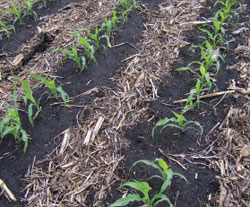 Strip-till is a method of seedbed preparation in which confined strips of soil are tilled prior to planting. Seeds are then planted directly into the tilled strips, leaving interrow areas protected by residue while avoiding residue contact with the seeds and seedling plants. Interest in strip-till has increased in recent years due to evidence that it combines many of the best aspects of no-till and conventional tillage systems.
Strip-till is a method of seedbed preparation in which confined strips of soil are tilled prior to planting. Seeds are then planted directly into the tilled strips, leaving interrow areas protected by residue while avoiding residue contact with the seeds and seedling plants. Interest in strip-till has increased in recent years due to evidence that it combines many of the best aspects of no-till and conventional tillage systems.
Benefits Over No-Till: Tilling in the row area encourages more favorable soil temperature, moisture and aeration conditions for germinating seeds and seedling plants, which can translate to improved crop establishment and early season performance. In addition to potential seedbed preparation advantages, strip-till also offers the opportunity to place fertilizers directly in the root zone, away from crop residues that could otherwise intercept or immobilize nutrients.
Benefits Over Conventional Tillage: Strip-till can provide conservation and efficiency benefits over conventional tillage practices. Leaving the interrow area untilled retains crop residues on the soil surface, providing increased erosion resistance and increased organic matter inputs. Strip-till can also reduce field passes and input costs compared to conventional tillage (Table 1).
(adapted from Randall and Hill, 2000).
| Tillage System | Field Operations | Minimum Field Passes |
| No-till |
Apply N; Plant (apply P and K w/planter) |
2 |
| Strip-till |
Strip Preparation (apply N, P and K w/tillage); Plant |
2 |
|
Reduced tillage |
Apply N; Apply P and K; Field Cultivate; Plant |
4 |
|
Conventional tillage |
Apply P and K; Chisel Plow; Apply N; Field Cultivate; Plant |
5 |
Strip-Till Systems
Strip-till is a general term used to describe a group of related tillage systems that share common practices and equipment but have different names and specific management elements that vary by state or region. The 4 most commonly used forms of strip-till are: fall strip-till; spring strip-till; zone-till; and in-row subsoiling.
Fall strip-till is the most commonly practiced strip-till system and is implemented by preparing 6- to 10-inch wide and 6- to 8-inch deep strips in the fall and planting directly into these without further tillage in the spring. As in most other strip-till systems, injection knives that are able to accommodate application of both anhydrous ammonia as well as dry (P and K) fertilizers can be used to prepare strips and make preplant fertilizer applications with a single field pass.
Spring strip-till is typically the same as fall strip-till in terms of equipment and field operation but with strip preparation occurring in the spring, directly prior to planting. The decision of whether to prepare strips in the spring versus fall depends on several issues, including field drainage and nitrogen (N) management strategy. Many producers, especially those managing poorly drained soils, prefer to prepare strips in the fall due to improved field access and tillage conditions. In contrast, other producers choose to prepare strips in the early spring when opportunities for N loss are reduced.
Zone-till is similar to other strip-till methods in terms of management objectives but uses less aggressive equipment. In a typical zone-till system, planting bands are created by coulters that disturb the soil to a depth of only 1 to 2 inches. In soils where subsurface compaction is not a problem, zone-till can deliver the same advantages as conventional strip-till with lower horsepower requirements.
In-row subsoil tillage is often used in soils where subsurface compaction is a concern. In-row subsoil tillage consists of a series of straight leg shanks that disturb narrow soil zones but can be adjusted to operate to a depth of 20 inches or more. In-row subsurface tillage is used to alleviate compaction layers in the area where the seed will be placed and is often used in conjunction with zone-till equipment to create a planting band that is equally as wide as that produced in other strip-till systems.
Strip-Till Equipment
Typical equipment requirements for strip-till include a heavy tool bar to which row markers, opening coulters, knives and covering disks are attached. Rolling harrow baskets and other seedbed conditioner attachments are often added to the back of the unit as well.
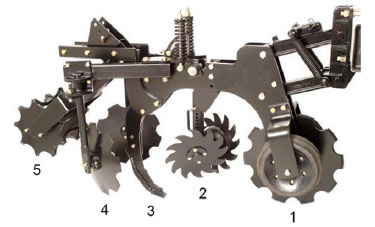
|
|
||||||||||||||||||||||
| Photo courtesy of Yetter Manufacturing. | |||||||||||||||||||||||
Zone-till units differ from those used for conventional strip-till in that they consist of a set of 2 or 3 offset, wavy or fluted coulters that disturb the soil surface only. In cases where subsurface compaction prevents the use of zone-till, in-row subsurface tillage units (referred to as “zone builders”) can be used in place of or in conjunction with zone-till equipment to achieve a restricted tillage band.
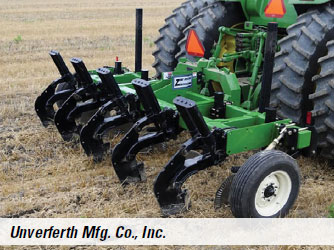
|
| Zone builder unit used for in-row subsoil tillage. |
Fertilizer Considerations
In order to maximize fertilizer efficiency gains in strip-till systems, N, P and K are best applied at the time of strip preparation. If strips are prepared in the spring and anhydrous ammonia is used as a source of N, application should occur at least 2 weeks before planting and at full tillage depth (6 to 8 inches) to prevent ammonia toxicity. Other fertilizer considerations for strip-till include:
- Fertilizer nutrients should be placed 3 to 6 inches below seeding depth in the tilled strip to optimize their location for early access by seedling plants.
- Banded application of less mobile nutrients, like P and K, can improve fertilizer efficiency on soils that have a low CEC or that have low to very low test levels.
- Subsurface fertilizer placement generally reduces the likelihood that soluble nutrients will be lost as run-off.
Crop Rotation and Corn Yields
The advantages of strip-till are generally most pronounced for corn following corn, where strip-till can help improve seedbed uniformity and reduce plant-to-plant variability compared to no-till. In a 4-year continuous corn study conducted on a loam soil in northern IN, corn yields under strip-till were 5% greater than in no-till and within 1% of full-width tillage (Figure 1).
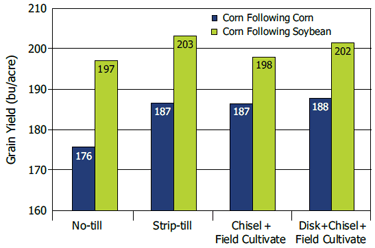
|
| Figure 1. Corn yield response to rotation and tillage system in a 4-year study conducted on a loam soil near Wanatah, IN (Vyn et al., 2006). |
In the same study, however, corn yields were similar for strip-till, no-till and full width tillage when corn was rotated with soybean. On cooler, poorly drained soils, strip-till can also provide a yield advantage over no-till when corn is rotated with soybean (Vetsch et al., 2007).
USDA Strip-Till Incentive Program
In many states, the USDA’s Natural Resources Conservation Service (NRCS) provides incentives through the Environmental Quality Incentives Program (EQIP) for transitioning to strip-till or no-till. For more information about financial support for transition to strip-till, visit your local USDA Service Center or the NRCS EQIP website.
Tips for Successful Strip-till
|
References
Randall, G., and P. Hill. 2000. Fall strip-tillage systems. p. 193-199. In R. Reeder (ed.) Conservation Tillage Systems and Management. MWPS-45. Midwest Plan Service. Ames, IA.
Vyn, T.J., T.D. West and P. Walker. 2006. Agronomic impacts of strip tillage and new reduced tillage systems in corn production. Pioneer Crop Management Research Award Summary.
Vetsch, J.A., G.W. Randall, and J.A. Lamb. 2007. Corn and soybean production as affected by tillage systems. Agron.J. 99: 952-959.

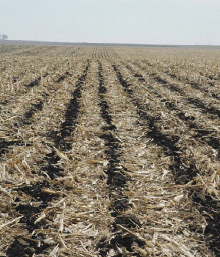 Strip placement: For corn on corn, avoid root balls by splitting the previous year’s row when making strips.
Strip placement: For corn on corn, avoid root balls by splitting the previous year’s row when making strips.



